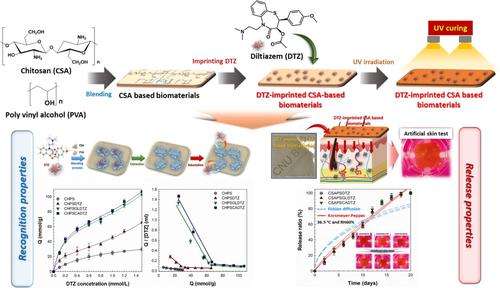Synthesis, recognition properties and drug release behavior of diltiazem-imprinted chitosan-based biomaterials
IF 2.7
3区 化学
Q2 POLYMER SCIENCE
引用次数: 0
Abstract
In this study, we prepared diltiazem (DTZ)-imprinted biomaterials for TDDS using chitosan, PVA, plasticizers, and sulfosuccinic acid. DTZ and the prepared biomaterials were characterized using field emission scanning electron microscopy, Fourier transform infrared, and 1H nuclear magnetic resonance. DTZ recognition properties were confirmed by the binding isotherm, Scatchard plot analysis, the adsorption of materials with structures similar to DTZ, selectivity factor (α), and the imprinting-induced promotion of binding (IPB). Results revealed that adsorbed amount (Q) of DTZ-imprinted biomaterials was 1.63–2.53 times higher than that of non-imprinted biomaterials. In addition, it could be verified that DTZ-imprinted biomaterials have a binding site for DTZ according to Scatchard plot analysis. Furthermore, the results of α and IPB indicated that the recognition capacity of the prepared DTZ-imprinted biomaterials is superior to that non-imprinted biomaterials. DTZ release properties were evaluated under various pH buffers and artificial skin. Results indicated that the DTZ release in buffers at low pH was faster than that in buffers at high pH. The DTZ release using artificial skin was continuous over 20 days. Furthermore, the DTZ release profile in the buffer followed the pseudo-Fickian diffusion mechanism, whereas the profile in the artificial skin test followed a non-Fickian diffusion mechanism.

地尔硫卓印迹壳聚糖基生物材料的合成、识别特性和药物释放行为
在这项研究中,我们使用壳聚糖、PVA、增塑剂和磺基琥珀酸制备了地尔硫卓(DTZ)印迹生物材料,用于 TDDS。利用场发射扫描电子显微镜、傅立叶变换红外线和 1H 核磁共振对 DTZ 和制备的生物材料进行了表征。通过结合等温线、斯卡查德图分析、吸附与 DTZ 结构相似的材料、选择性因子 (α)、印迹诱导的促进结合 (IPB) 等方法证实了 DTZ 的识别特性。结果表明,DTZ印迹生物材料的吸附量(Q)是非印迹生物材料的1.63-2.53倍。此外,根据 Scatchard plot 分析,可以证实 DTZ 压印生物材料具有 DTZ 的结合位点。此外,α 和 IPB 的结果表明,制备的 DTZ 压印生物材料的识别能力优于非压印生物材料。在不同的 pH 缓冲液和人造皮肤条件下,对 DTZ 的释放特性进行了评估。结果表明,DTZ 在低 pH 值缓冲液中的释放速度快于在高 pH 值缓冲液中的释放速度。人工皮肤的 DTZ 释放持续了 20 天。此外,DTZ 在缓冲液中的释放曲线遵循伪菲克西扩散机制,而在人造皮肤试验中的释放曲线遵循非菲克西扩散机制。
本文章由计算机程序翻译,如有差异,请以英文原文为准。
求助全文
约1分钟内获得全文
求助全文
来源期刊

Journal of Applied Polymer Science
化学-高分子科学
CiteScore
5.70
自引率
10.00%
发文量
1280
审稿时长
2.7 months
期刊介绍:
The Journal of Applied Polymer Science is the largest peer-reviewed publication in polymers, #3 by total citations, and features results with real-world impact on membranes, polysaccharides, and much more.
 求助内容:
求助内容: 应助结果提醒方式:
应助结果提醒方式:


